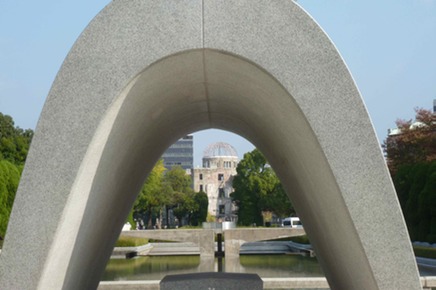The city’s name means Wide Island and Hiroshima was founded on the delta formed by the Ota River, flowing out to the Seto Inland Sea in 1589. Mori Terumoto, a powerful warlord made it his capital after leaving Koriyama Castle in Aki Province, built Hiroshima Castle, moved there in 1593 but was on the losing side in the Battle of Sekigahara, which marked the start of the Tokugawa shogunate. Tokugawa Ieyasu gave control of the area to the Asano clan of samurai, who ruled the area until the Meiji Restoration in 1868. Under their rule the city prospered and expanded and their descendants were strong supporters of modernization through the Meiji period, Hiroshima became a major industrial centre as the Japanese economy shifted from primarily rural to urban industries and a busy port.
The Sanyo Railway reached Hiroshima in 1894, and the city was a major military centre during the First Sino-Japanese War with the Japanese government temporarily based there during the war. Emperor Meiji made his headquarters at Hiroshima Castle from 15 September 1894 to 27 April 1895 and the first round of peace talks to end the war was held in Hiroshima in early February 1895. Hiroshima was a major supply base during the Russo-Japanese War in 1904 and a focal point of military activity when the Japanese government entered the First World War on the Allied side. The Hiroshima Prefectural Commercial Exhibition Hall, constructed in 1915 as a centre for trade and the display of new products was the closest surviving building to the atomic detonation, designated the Genbaku or Atomic Dome, as part of the Hiroshima Peace Memorial Park.
 The city was a major military base again during World War II, with large depots of military supplies, and was a key hub for shipping but while there was widespread destruction and hundreds of thousands died in Tokyo and other cities there were no air raids in Hiroshima although students aged eleven to fourteen were mobilized to demolish houses and create firebreaks to protect against potential firebombings.
The city was a major military base again during World War II, with large depots of military supplies, and was a key hub for shipping but while there was widespread destruction and hundreds of thousands died in Tokyo and other cities there were no air raids in Hiroshima although students aged eleven to fourteen were mobilized to demolish houses and create firebreaks to protect against potential firebombings.
Just over a month after the bombing the Makurazaki Typhoon (Typhoon Ida) killed and injured another three thousand, destroyed more than half the remaining bridges in the city and added further heavy damage to roads and railroads but Hiroshima was rebuilt with help from the national government that provided financial assistance and land donated previously used for military purposes.
There, in a nutshell, you have the Hiroshima story, and when you walk (or, in our case, travel by tram) through the downtown area on your way to the Atomic Dome you're seeing a remarkable recovery, proof that, if such an event were to happen again, on a small scale, and at the same intensity of blast, recovery might be possible.
On the other hand, as a guide addressing a tour group about ten metres to my left as I stood dabbing at my misty eyes and gazing at the Dome, today's nuclear weapons are much larger and infinitely more powerful. There's a mist over my eyes as I type this, and reflect on a time when a small boy lived in dread that Hiroshima was about to be repeated on a worldwide scale.
But it's a place that needs to be visited, an event that needs to be remembered, and a mid-city environment that has been shaped to deliver a serenity and quiet dignity that's impressive given the awful magnitude of the event it commemorates.
We could have gone further, and made our way into the Peace Museum, but chose instead to walk slowly through the parkland, reflecting on events and trying not to think about events on the other side of the world that will shape the way things go for the next four years.